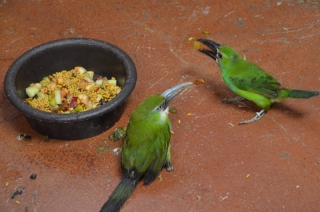Interview with Greg Poulain
Emily: How long has Black Hills Parrot Welfare been involved in avian rescue?
Greg: BHPW has been an Incorporated non profit since 2007 but Cindy and I have been involved with birds since the 70’s
Emily: You don’t like your facility being referred to as a rescue – can you explain to readers why that is?
Greg: I could go on forever about why we don’t use the word rescue. But since we are involved with all aspects of the avian world we are aware that the majority of our work seldom is directly related to rescue. Although those cases do exist. If we were not involved with what we do, we would need to seek provisions for our birds after we were gone like so many other people, and the word rescue by itself says that all birds are in need of better circumstances when in fact most of the birds we deal with have come from excellent homes with good diet, love and stimulation. We also feel that the use of some words and slogans have been counterproductive to the avian community.
Emily: I really enjoyed learning about and seeing your softbills – including the toucans – during our visit. Can you tell readers a bit about the toucans, why you have them, and how you are using them in educational programs?
Greg: We have a love for “all” birds, and softbills are a group that we have spent many years studying and caring for. Many people seldom have the chance to see and experience this side of aviculture and understand the need for conservation. Nearly all of the softbills in our program have come from different zoo’s for rehabilitation efforts and are used in school and public education programs.
Emily: You mentioned working closely with zoos and one day being AZA certified – can you tell our readers more about that, and how it will help further the mission of your facility?
Greg: Our work with zoo’s enable us to network with some awesome and innovative veterinarians, allows us to get the most current data on conservation efforts, is a good source for species survival planning and species champions. We hope that someday our continued work with zoo’s will develop into a more involved role in conservation.
Emily: Perhaps one of your most well known birds in residence is Peaches, the cockatoo. Can you tell readers more about her and her background?
Greg: Our records indicate that about 18% of our birds have come from documented abuse cases and one of the notable ones that most of our returning visitors identify with is Peaches. A 68 year old Moluccan Cockatoo. This is a good example of why we need to plan for our birds before our passing. She lived with the same family for approx. 58 years and after the death of both of her caregivers within a year, she was passed through several homes and ultimately ended up in one that severely abused her. She has had boiling hot water thrown on her, had head injuries resulting in blindness and has had to have surgeries to repair damage. This is now a bird after extensive rehabilitation that once again has regained human trust and will greet every single visitor with a head bow for a loving head scratch.
We feel it is very important to lead by example. Our facility is open to the public and seldom do we actively solicit for donations. Our philosophy is that when a person takes the time to visit us first hand and they believe in what we do, then we have a supporter for life. The most common comment we get from bird people is “your birds look so happy and healthy”. Our answer “love, dedication, education and experience”
Categories: Blog

Add a Comment
You must be logged in to post a comment.